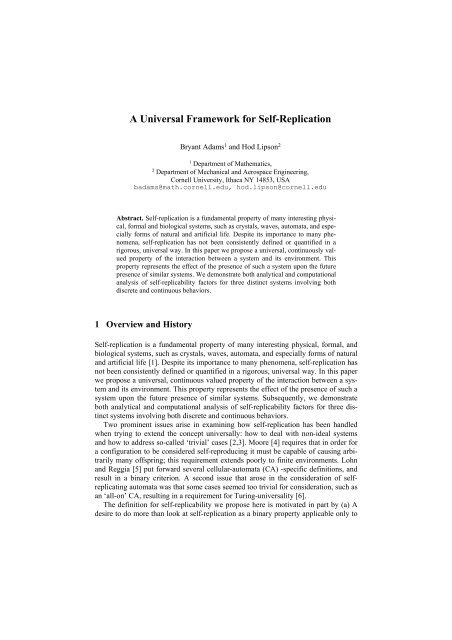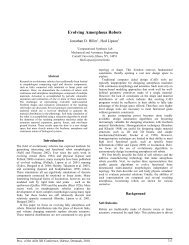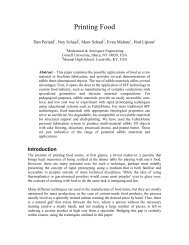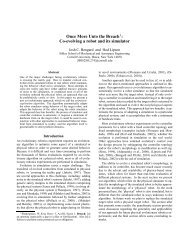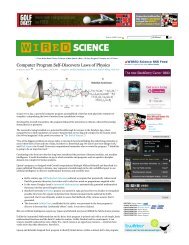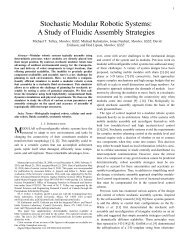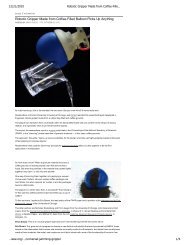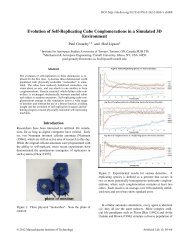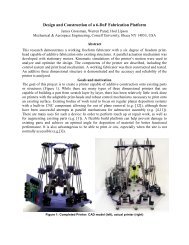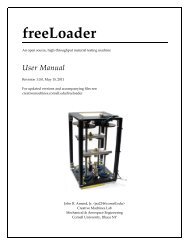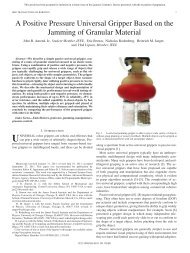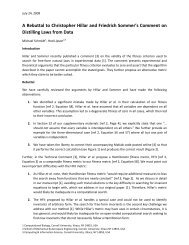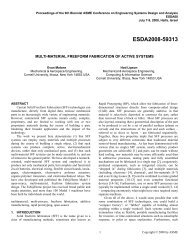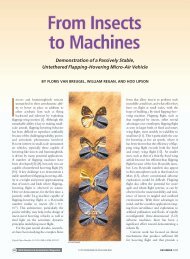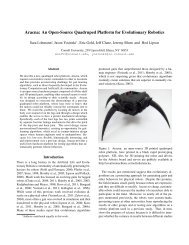A universal framework for self-replication - Cornell Creative ...
A universal framework for self-replication - Cornell Creative ...
A universal framework for self-replication - Cornell Creative ...
Create successful ePaper yourself
Turn your PDF publications into a flip-book with our unique Google optimized e-Paper software.
A Universal Framework <strong>for</strong> Self-Replication<br />
Bryant Adams 1 and Hod Lipson 2<br />
1 Department of Mathematics,<br />
2 Department of Mechanical and Aerospace Engineering,<br />
<strong>Cornell</strong> University, Ithaca NY 14853, USA<br />
badams@math.cornell.edu, hod.lipson@cornell.edu<br />
Abstract. Self-<strong>replication</strong> is a fundamental property of many interesting physical,<br />
<strong>for</strong>mal and biological systems, such as crystals, waves, automata, and especially<br />
<strong>for</strong>ms of natural and artificial life. Despite its importance to many phenomena,<br />
<strong>self</strong>-<strong>replication</strong> has not been consistently defined or quantified in a<br />
rigorous, <strong>universal</strong> way. In this paper we propose a <strong>universal</strong>, continuously valued<br />
property of the interaction between a system and its environment. This<br />
property represents the effect of the presence of such a system upon the future<br />
presence of similar systems. We demonstrate both analytical and computational<br />
analysis of <strong>self</strong>-replicability factors <strong>for</strong> three distinct systems involving both<br />
discrete and continuous behaviors.<br />
1 Overview and History<br />
Self-<strong>replication</strong> is a fundamental property of many interesting physical, <strong>for</strong>mal, and<br />
biological systems, such as crystals, waves, automata, and especially <strong>for</strong>ms of natural<br />
and artificial life [1]. Despite its importance to many phenomena, <strong>self</strong>-<strong>replication</strong> has<br />
not been consistently defined or quantified in a rigorous, <strong>universal</strong> way. In this paper<br />
we propose a <strong>universal</strong>, continuous valued property of the interaction between a system<br />
and its environment. This property represents the effect of the presence of such a<br />
system upon the future presence of similar systems. Subsequently, we demonstrate<br />
both analytical and computational analysis of <strong>self</strong>-replicability factors <strong>for</strong> three distinct<br />
systems involving both discrete and continuous behaviors.<br />
Two prominent issues arise in examining how <strong>self</strong>-<strong>replication</strong> has been handled<br />
when trying to extend the concept <strong>universal</strong>ly: how to deal with non-ideal systems<br />
and how to address so-called ‘trivial’ cases [2,3]. Moore [4] requires that in order <strong>for</strong><br />
a configuration to be considered <strong>self</strong>-reproducing it must be capable of causing arbitrarily<br />
many offspring; this requirement extends poorly to finite environments. Lohn<br />
and Reggia [5] put <strong>for</strong>ward several cellular-automata (CA) -specific definitions, and<br />
result in a binary criterion. A second issue that arose in the consideration of <strong>self</strong>replicating<br />
automata was that some cases seemed too trivial <strong>for</strong> consideration, such as<br />
an ‘all-on’ CA, resulting in a requirement <strong>for</strong> Turing-<strong>universal</strong>ity [6].<br />
The definition <strong>for</strong> <strong>self</strong>-replicability we propose here is motivated in part by (a) A<br />
desire to do more than look at <strong>self</strong>-<strong>replication</strong> as a binary property applicable only to
certain automata, and, (b) The goal of encapsulating a general concept in a means not<br />
reliant upon (but compatible with) ideal conditions.<br />
We wish to do this by putting <strong>self</strong>-<strong>replication</strong> on a scale that is algorithmically calculable,<br />
quantifiable, and continuous. Such a scale would allow <strong>for</strong> comparisons, both<br />
between the same system in different environments, determining ideal environments<br />
<strong>for</strong> a system’s <strong>replication</strong>, as well as between different systems in the same environment,<br />
if optimizing replicability in a given environment is desired.<br />
Rather than viewing <strong>self</strong>-replicability as a property purely of the system in question,<br />
we view it as a property of the interaction between a system and its environment.<br />
Self-Replication, as we present it, is a property embedded and based upon in<strong>for</strong>mation,<br />
rather than a specific material <strong>framework</strong>. We construct replicability as a property<br />
relative to two different environments, which indicates the degree to which one<br />
environment yields a higher presence of the system over time. Self-replicability, then,<br />
is a comparison between an environment lacking the system and an environment in<br />
which the system is present. We will first introduce a number of definitions, and then<br />
give examples of replicability of three types of systems.<br />
2 Definitions<br />
Definition 1: Environment. By Environment we denote a single state of a (presumably<br />
closed) system.<br />
For example, with a closed system such as a 5×5 grid, each of whose cells may be<br />
either ‘on’ or ‘off’, one environment, E1, would be ‘all 25 cells off’, while another,<br />
E2, might be ‘every other cell on’.<br />
Definition 2: Set of configurations. Given an environment E, the set of configurations<br />
E is the set of all possible states of the system that includes state E. We call<br />
elements of E ”E-configurations”.<br />
We do not assume an arrow of time, and thus if, <strong>for</strong> some environments E1, E2, we<br />
have E1 ∈ E2<br />
, then E2 ∈ E1<br />
and E 1 = E2<br />
. In the 5×5 grid, <strong>for</strong> example, the set of<br />
configurations would be the collection of all 2 25 states the grid could be in.<br />
Definition 3: Time development function. A time development function is a map<br />
T E × ℜ → E<br />
+<br />
: , (respectively E × Z → E<br />
+<br />
T :<br />
<strong>for</strong> discrete time systems) constrained<br />
by T(E,0)=E and T(T(E,y),x)=T(E,x+y).<br />
With a time development function, we operate under the assumption that the progression<br />
between states as time passes is externally deterministic. We also assume<br />
there is no difference between a system that ‘ages’ five units and then ten units, and a<br />
system that first ages ten units, and then ages five units. When we write only T(E)<br />
rather than T(E, n), it is assumed there is a natural increment of time and we are using<br />
T(E, 1).
Definition 4: Subsystem set. We denote by X* the collection of all subsystems of a<br />
given system X, and say X* is the subsystem set of X.<br />
Often, we are most interested in the subsystem set of an environment. For example,<br />
in the case where the system is a 5×5 grid and E is a state with all points being<br />
off, E* would include, among its 2 25 elements, four 4×4 binary grids with all points<br />
being off, five 1×5 binary grids with all points being off, and a number of L-shaped<br />
binary grids with all points being off. For further example, given a second system E2,<br />
a 5×5 grid in which the top row of points were on, the rest off, E2* would still have<br />
2 25 elements, each the same shape as a corresponding element in E*, but now some<br />
elements would include ‘on’ points.<br />
Definition 5: Possible Subsystems. We define the possible subsystems<br />
union of all F* such that F ∈ E .<br />
In the case of the binary grid, the elements of<br />
*<br />
E as the<br />
*<br />
E could be classified into 2 25 dis-<br />
tinct shapes, and each shape-class would have 2 n elements, with n being the number<br />
of cells in that shape.<br />
Definition 6: Dissimilarity pseudometric. To quantify the ‘<strong>self</strong>’ portion of <strong>self</strong>-<br />
+<br />
<strong>replication</strong>, we assume that a dissimilarity metric × → ℜ<br />
* *<br />
d : E E is given. Recall a<br />
pseudometric d obeys d(x,y)+d(y,z)≥ d(x,z), d(x,y)≥ 0, and d(x,x)=0.<br />
Note that d induces an equivalence relation on<br />
*<br />
E . That is, we say <strong>for</strong><br />
*<br />
1, S2<br />
E<br />
S ∈ ,<br />
that S1 ≡ S2<br />
exactly when d(S1,S2)=0.<br />
Presumably, the dissimilarity metric would be<br />
chosen such that it induced a natural equivalence relation, but this choice is not assumed.<br />
Definition 7: Presence. We define the presence Pε(E,S) of a subsystem S in an environment<br />
E within tolerance ε to be the measure E* normalized to 1. I.e, it is the probability<br />
that a randomly selected subsystem T∈E* will satisfy d(T,S)≤ ε.<br />
Essentially, the presence function measures ‘how much’ S is found in E. As a<br />
probability, P takes values in the interval [0, 1]. In the case of discrete environments,<br />
the presence function essentially reduces to counting, and in a continuous case we<br />
(temporarily) increase the measure of the set by using a nonzero tolerance.<br />
Definition 8: ε-Present, ε-Possible. When Pε(E,S)≠ 0, we say that S is ε-present (in<br />
E). Also, we say that S is ε-possible (in E) when there is some time t∈R + such that S is<br />
ε-present in T(E,t).<br />
Definition 9: Replicability, Momentary. Given a set of configurations E and two Econfigurations<br />
E1, E2, we define the momentary relative replicability of a system S in<br />
E1 relative to E2 with tolerance ε at time t as<br />
Pε<br />
( T ( E1,<br />
t),<br />
S)<br />
RM ( S,<br />
E1,<br />
E2,<br />
ε , t)<br />
= log<br />
(1)<br />
Pε<br />
( T ( E2,<br />
t),<br />
S)<br />
The ratio in Eq. (1) serves to compare the probability at time t of finding S in the<br />
future of E1 to the probability at the same time of finding S in the future of E2. There<br />
are a few cases where Eq. (1) is undefined. If Pε(T(E1,t),S)=Pε(T(E2,t),S) (including
zero) we define RM as 0. When Pε(T(E1,t),S)=0 but S is ε-present in T(E2,t), we define<br />
RM as –∞,and when Pε(T(E2,t),S)=0 but S is ε-present in T(E1,t), we define RM as ∞.<br />
In the case where S is not ε-possible in either or both of E1 and E2, we will not define<br />
replicability. In these cases, we would generate ratios comparing possibly nonzero<br />
quantities to zero quantities, which would fail to yield meaningful in<strong>for</strong>mation.<br />
We explain the rationale <strong>for</strong> using the logarithm after all the definitions have been<br />
presented.<br />
Definition 10: Replicability, Over time. In the case where S is ε-possible in both E1<br />
and E2, we also define the replicability over time τ0 to τ1 (in E1 relative to E2 with<br />
tolerance ε) as:<br />
τ<br />
1 ∫t<br />
= τ Pε<br />
( T ( E1,<br />
t),<br />
S)<br />
dt<br />
0<br />
RT<br />
( S,<br />
E1,<br />
E2<br />
, ε,<br />
τ 0,<br />
τ1)<br />
= log<br />
τ<br />
(2)<br />
1 ∫ P ( T ( E , t),<br />
S)<br />
dt<br />
t=<br />
τ 0<br />
Note that <strong>for</strong> discrete systems, integral reduces to a simple sum.<br />
Definition 11: Replicability, Overall. We define the Overall Replicability as the limiting<br />
case: S,<br />
E , E , ε ) = lim R ( S,<br />
E , E , ε,<br />
0,<br />
t)<br />
RO ( 1 2<br />
T 1 2<br />
t→∞<br />
Note that, by using the logarithm of the fractions, we have an additive <strong>for</strong>m <strong>for</strong><br />
some basic relations. Letting R(S, E1, E2) stand in <strong>for</strong> any of the defined types of<br />
replicability, letting S be a fixed system, and letting A, B, C ∈ C , we have:<br />
R(<br />
S,<br />
A,<br />
B)<br />
+ R(<br />
S,<br />
B,<br />
C)<br />
= R(<br />
S,<br />
A,<br />
C)<br />
R(<br />
S,<br />
A,<br />
B)<br />
= −R(<br />
S,<br />
B,<br />
A)<br />
(3)<br />
R(<br />
S,<br />
A,<br />
A)<br />
= 0<br />
The last relation highlights that replicability is being taken as a relative, rather than<br />
absolute, concept. When a replicability value is zero, we have two environments in<br />
which a system fares equally well. In order to relate the replicabilities of systems in<br />
different environments, we will specifically consider cases where S is present in E1, is<br />
not present in E2, and d(E1, E2) is minimal. In these cases, we are making a comparison<br />
between a ‘blank’ environment and one that is minimally different, in order to<br />
reflect a minimally disturbing introduction of a system into the environment. For<br />
example, in modeling a crystal, we might consider a supersaturated solution as E2,<br />
and a supersaturated solution with a tiny seed crystal as E1, but we would not consider<br />
a fully crystallized configuration <strong>for</strong> E1.<br />
In particular, let an environment E and a system S be given, such that S is minimally<br />
ε-present in E. Let E’ = E − S denote some E’∈ E such that d(E, E’) is minimal,<br />
and S is not ε-present in E’ but is ε-possible in E’. This leads to the particular<br />
case of <strong>self</strong>-replicability we wish to examine.<br />
Definition 12: Self-Replicability, Overall. With E, S, and E – S given as above, we<br />
define the <strong>self</strong>-replicability of a system S in an environment E as<br />
( S,<br />
E,<br />
ε ) = R ( S,<br />
E,<br />
E − S,<br />
ε ) .<br />
RS O<br />
In essence, RS looks at how present S becomes when it was at one point specifically<br />
in the environment, compared to how develops without prompting. If RS is zero,<br />
then the inclusion of S neither adds nor detracts from the future presence of S. A<br />
ε<br />
2
positive value of RS indicates that including the system results in a higher presence of<br />
the system in the future, i.e. the system appears to be <strong>self</strong>-replicating. A negative<br />
value indicates that including the system has a detrimental effect, and that the system<br />
is essentially <strong>self</strong>-defeating. Infinite values, both positive and negative, arise when the<br />
magnitude of the influence of the system increases at a more than linear rate as time<br />
goes on. This can happen in particular when the lifespan of a system is finite in one of<br />
E or E–S and infinite in the other.<br />
3 Examples<br />
3.1 Cellular Automaton<br />
Our first system is a cellular automaton given by single-cycle graph with five nodes,<br />
each of which can take the state of ‘on’ or ‘off’, along with radius-1 evolution rules<br />
(Fig. la). Up to rotations and reflections of the graph, there are eight distinct states the<br />
system can take. There are two limit cycles under the evolution rule: First, the ‘all on’<br />
state is sent to the ‘all off’ state, which is then sent to the ‘all on’ state again. Second,<br />
the remaining six states are transitive under the action of the evolution rule.<br />
Fig. 1. (a) Table of the 8 evolution rules defining a one dimensional CA of radius I and (b)<br />
Two examples of subsystems. We will calculate the <strong>self</strong>-replicability of the one labeled S<br />
Fig. 2. Cellular Automaton system: Successive states of E 0 and E 1 under T<br />
Examples of two subsystems are shown in Fig. lb. As this is a discrete system, we can<br />
move directly to the zero-tolerance case, and thus need to define only the preimage of<br />
zero under dissimilarity metric (i.e. establish the meaning of ‘identical’.) There are 32<br />
configurations, of which only eight are distinct, and each configuration has 32<br />
subsystems. We define a dissimilarity metric that is zero when the subsystems being<br />
compared have, up to rotation and flipping, the same shape and pointwise parity. We<br />
now compute the values T(E0, n) and T(E0, n) by applying the evolution rule. The<br />
results are seen in Fig. 2. Note that T(E0, n) = T(E0, n+2) and T(E1, n)= T(E1, n+6).<br />
This cyclic nature of the environment under time development will allow us to find<br />
the (overall) <strong>self</strong>-replicability, rather than just the <strong>self</strong>-replicability over some constrained<br />
time. Next, we calculate the ‘presence’ of the subsystem S (see Fig. 1b) in
each of T(E0,1, t), t∈{0,1,2,3,4,5}, by counting how many times it occurs in each time<br />
step. The results are presented in Table 1. We now take the log of the quotient of the<br />
sums, yielding log(7/15) = –0.762 <strong>for</strong> the <strong>self</strong>-replicability over t = 0...5.<br />
Table 1. Cellular Automaton system: Time and Presence of S in E 0 and in E 1<br />
Time (t) 0 1 2 3 4 5 Totals<br />
P(T(E0,t),S) 0 5 0 5 0 5 15<br />
P(T(E1,t),S) 1 1 3 2 0 0 8<br />
3.2 Ring system<br />
The second system gives an example where the amount of in<strong>for</strong>mation in the environment<br />
grows as the time development function is applied. For conceptualization<br />
purposes, the system can be seen as an ideal closed fiber-optic ring (Fig. 3D), with a<br />
number of irregularities (Fig. 3B, Fig 3G) that act as beam splitters (Fig. 3B), into<br />
which a pattern of moving light, packets (Fig 3C) can be injected. We assume that<br />
light packets travel at a constant speed, clockwise or counterclockwise.<br />
Fig. 3. Illustration of example Ring System. A: A system with potential replicability (a pattern<br />
to match) B: An irregularity with recently split packets C: optical packets D: center of the ring<br />
E: the system (A) acceptably matching a set of packets, F: the system (A) not acceptably<br />
matching a set of packets G: location of a second irregularity.<br />
The problem becomes interesting when allowing <strong>for</strong> beam-splitting irregularities that<br />
divide the ring into irrational proportions. In this case, no steady state exists. While<br />
any initial distribution should become densely spread over the ring, the distribution is<br />
not necessarily uni<strong>for</strong>m: thus, the presence of a given pattern is possibly nontrivial.<br />
For this example, a direct computer model was used, storing the initial conditions<br />
(initial light configuration and irregularity locations) and applying the time development<br />
rules to determine the location, direction, and intensity of all resulting light
packets. The model was simulated and, in many cases, our hardware was not able to<br />
run enough time steps to suggest a long-term trend. However, all RS values were no<br />
greater than 1 in absolute value. Those values that appeared to converge rapidly had a<br />
<strong>self</strong>-replicability factor between 0.5 and 0.9.<br />
3.3 Crystal growth system<br />
The final example is a model of a physical system that is analyzed analytically, rather<br />
than explicitly simulated. The goal is to measure the replicability of a crystal satisfying<br />
two properties: (a) once a seed crystal is established, the presence of the crystal in<br />
the environment is given as a function of time. For this example, we specify an exponential<br />
function of time, and (b) there is a fixed nonzero probability rate c∈(0,1] at<br />
any given time of a seed crystal spontaneously <strong>for</strong>ming. This guarantees that a crystal<br />
S is always possible in an environment E, and the replicability thus is defined.<br />
Fig. 4. Plot of the log of the crystal model<br />
presence, log(Pε(T(E 1,t),S)) vs. t <strong>for</strong> different<br />
values of c, the probability of random crystal<br />
<strong>for</strong>mation. We use the logarithm to make<br />
long-term behavior more visible.<br />
Fig. 5. Plot of R T(E 1,E 2,S,ε,0,t) vs. t <strong>for</strong> the<br />
crystal model , showing the same values of c<br />
as in Fig. 4. Note that R T converges quickly<br />
(toward R O) as t becomes large.<br />
In this model, we require that the presence of crystal in the environment increase<br />
exponentially from the time a seed crystal is inserted, i.e. Pε(T(E0,t),S)=e t . Thus, during<br />
the period while e t
4 Conclusions<br />
We have proposed a means of measuring the fundamental property of <strong>self</strong>-<strong>replication</strong>,<br />
seeking a graded measure that can be <strong>universal</strong>ly applied to systems from cellular<br />
automata to living systems. We provided three examples that involved various mixtures<br />
of discrete and continuous variables and were handled both through direct simulation<br />
and analytical modeling. This property is not simply seen as intrinsic to a system,<br />
but is found in the in<strong>for</strong>mation that arises from the interaction between a system<br />
and its environment.<br />
We currently see two branches of further immediate investigation. On the theoretical<br />
side, while a few properties such as additivity in Eq (3) are known, other properties<br />
such as continuity of the replicability function warrant further investigation. On<br />
the applied side, it would be desirable to find practical ways to calculate replicability<br />
in more intricate systems, such as simple biological auto-catalyzing enzymes and cell<br />
models, and artificial systems ranging from molecules, to blocks [7] and to machines<br />
[8]. Ultimately, we seek to get a better idea of the scale into which interesting replicabilities<br />
fall and the conditions under which <strong>self</strong>-<strong>replication</strong> is maximized.<br />
Acknowledgment<br />
This work was supported by the U.S. Department of Energy, grant DE-FG02-<br />
01ER45902.<br />
References<br />
1. Sipper, M., Reggia, J.A., Go <strong>for</strong>th and replicate. In: Scientific American 285/265(2),<br />
August 2001, 35-43<br />
2. Nehaniv C., Dautenhahn K., Self-Replication and Reproduction: Considerations and<br />
Obstacles <strong>for</strong> Rigorous Definitions. Abstracting and Synthesizing the Principles of<br />
Life, Verlag Harri Deutsch, pp. 283-290, 1998.<br />
3. McMullin, B, John von Neumann and the Evolutionary Growth of Complexity: Looking<br />
Backward, Looking Forward In: Artificial Life 6 (2000) 347-361Sanchez,<br />
4. Moore, E. F., Machine Models of Self-Reproduction in Burks, A. W., Essays on Cellular<br />
Automata (1970) 187-203<br />
5. Lohn J.D. Reggia J.A. (1997). Automatic discovery of <strong>self</strong>-replicating structures in<br />
cellular automata. IEEE Trans. Evolutionary Computation, 1(3):165-178<br />
6. Von Neumann, J, completed and edited by Burks, A. W., Von Neumann's Self-<br />
Reproducing Automata In: Burks, A. W., Essays on Cellular Automata (1970) 4-65<br />
7. Penrose, L.S., Self-reproducing machines. In: Scientific American, 200 (6) (1959)<br />
105-114<br />
8. Chirikjian, G.S., Zhou, Y., Suthakorn, J., Self-replicating Robots <strong>for</strong> Lunar Development,<br />
In: IEEE/ASME Trans. on Mechatronics 7. 4 (2002) 462-472


